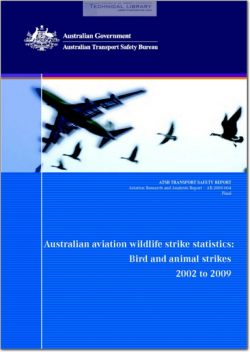ATSB-AR-2009-064
- Version
- 211 Downloads
- 2.28 MB File Size
- 1 File Count
- August 9, 2016 Create Date
- August 9, 2016 Last Updated
Australian Wildlife Strike Statistics; Bird and Animal Strikes - 2002 to 2009

A significant proportion of all occurrences reported to the Australian Transport Safety Bureau (ATSB)
involve aircraft striking wildlife, especially birds. This report provides aviation birdstrike and animal strike
occurrence data for the period 1 January 2002 to 31 December 2009. It also describes the results of an ATSB
survey of aerodromes concerning current wildlife control measures.
Reported birdstrikes have been generally increasing since 2002. In 2009, there were 1,340 birdstrikes
reported to the ATSB. For high capacity aircraft operations, reported birdstrikes have doubled from 2002 to
2009. However, taking into account an increase in aircraft movements, this increase is modest and is
probably accounted for by a generally improving reporting culture within this time.
Birdstrikes have increased for the period of study in every Australian state and territory. Queensland, New
South Wales, the Northern Territory and Western Australia have the highest birdstrike rates. The higher
birdstrike numbers for Queensland and the Northern Territory may be related to bird populations within the
tropics, while New South Wales has the highest number of major aerodrome aircraft movements in Australia.
Most birdstrikes occur within the confines of aerodromes (less than 5 km). Major and regional towered
aerodromes had significantly higher rates of reported birdstrikes than General Aviation Airport Procedures
(GAAP) aerodromes, and had considerably increasing rates from 2002 to 2009. GAAP aerodrome birdstrike
rates do not appear to have changed.
Engine ingestion makes up 11 per cent of all birdstrike occurrences in high capacity air transport for the 8-
year period, and the highest number of damaging birdstrikes occurs in high capacity air transport. Birdstrikes
causing multiple parts damaged were not common throughout the period. General aviation had the highest
proportion of damaging birdstrikes, with almost 24 per cent of birdstrikes causing damage. Aeroplane wings
and helicopter rotor blades are the most commonly damaged aircraft components across all operational types,
particularly in general aviation. There have been eight occurrences from the period of 2002-2009 that have
resulted in serious aircraft damage, and four that have resulted in injury.
| File | Action |
|---|---|
| ATSB-AR-2009-064 Australian Wildlife Strike Statistics; Bird and Animal Strikes - 2002 to 2009.pdf | Download |

Comment On This Post